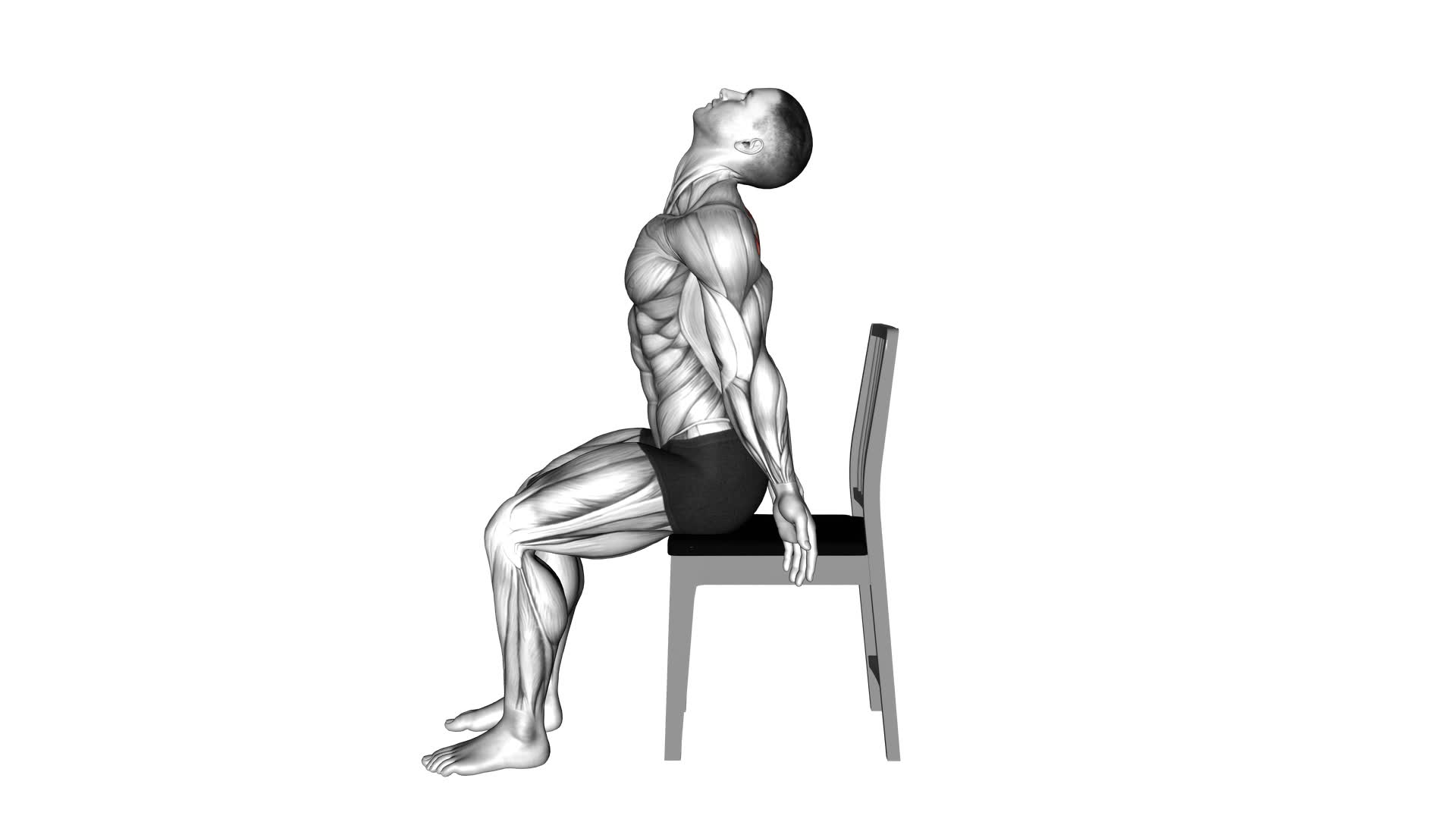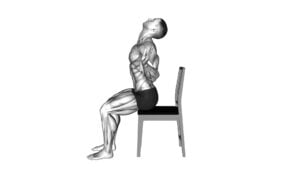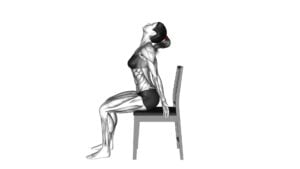Sitting Scapular Adduction (male) – Video Exercise Guide & Tips

Are you looking to improve your posture and strengthen your upper back?
Watch This Exercise Video
In this video exercise guide, we will show you how to perform the Sitting Scapular Adduction exercise. This targeted exercise is designed to activate and strengthen the muscles in your upper back and shoulders.
By following our step-by-step guide and avoiding common mistakes, you can maximize the effectiveness of this exercise.
Get ready to improve your posture and build a stronger upper body.
Let's get started!
Key Takeaways
- The sitting scapular adduction exercise improves posture by pulling shoulder blades back and down.
- It alleviates strain on the neck and upper back.
- The exercise strengthens scapular muscles responsible for stability.
- Proper form and technique are important to maximize muscle activation and reduce the risk of injury.
Benefits of Sitting Scapular Adduction Exercise
By practicing the Sitting Scapular Adduction exercise, you can experience a range of benefits that will improve your posture and upper body strength. Scapular stability is of utmost importance when it comes to maintaining proper posture. The scapulae, or shoulder blades, play a crucial role in supporting the upper body and allowing for smooth movement of the arms and shoulders. Weak scapular muscles can lead to rounded shoulders and a hunched posture, causing strain on the neck and upper back.
The Sitting Scapular Adduction exercise specifically targets the muscles responsible for scapular stability, helping to strengthen and stabilize them. By performing this exercise regularly, you can improve your posture by pulling your shoulder blades back and down, promoting a more upright position. This not only enhances your physical appearance but also helps to alleviate strain on the neck and upper back.
In addition to improving posture, the Sitting Scapular Adduction exercise also strengthens the muscles of the upper body, including the rhomboids, trapezius, and deltoids. These muscles play a vital role in activities such as lifting, carrying, and pushing. By strengthening these muscles, you can enhance your upper body strength, making daily tasks easier and reducing the risk of injury.
Now that you understand the importance of scapular stability and how the Sitting Scapular Adduction exercise can improve your posture and upper body strength, let's move on to discussing the equipment needed for this exercise.
Equipment Needed for the Exercise
To properly perform the sitting scapular adduction exercise, you'll need some essential equipment.
First, you'll need a sturdy chair or bench to sit on. This will provide a stable base for the exercise.
Additionally, you'll need a resistance band or dumbbells to add resistance to the movement and challenge your muscles.
These equipment options will allow you to effectively target your scapular muscles and improve your upper body strength and posture.
Essential Equipment for Exercise
You will need a resistance band for the Sitting Scapular Adduction exercise. This exercise targets the muscles in your upper back and shoulders, helping to improve posture and upper body strength.
In addition to the resistance band, there are a few other essential pieces of exercise equipment that can enhance your workout and ensure proper form and safety. Here are two sub-lists to consider:
Resistance Bands:
- Mini loop bands
- Tube bands
Additional Workout Gear:
- Dumbbells
- Exercise mat
Using resistance bands allows for adjustable resistance levels, making it suitable for beginners and advanced users alike. Mini loop bands are perfect for targeting smaller muscle groups, while tube bands are ideal for full-body workouts. Dumbbells can be used to increase the intensity of certain exercises, and an exercise mat provides cushioning and support for floor exercises.
Now that you know the essential equipment for this exercise, let's move on to the next section about proper gear for exercise.
Proper Gear for Exercise
To properly engage in the Sitting Scapular Adduction exercise, you'll need specific gear.
While this exercise doesn't require any exercise accessories, it's important to wear the right attire for optimal performance and safety.
For this exercise, it's recommended to wear comfortable workout clothes that allow for a full range of motion. Choose clothing that isn't too tight or restrictive, as this can hinder your movement.
Additionally, it's important to wear proper athletic shoes that provide stability and support to your feet. This will help maintain proper alignment and reduce the risk of injury.
Equipment Options for Exercise
For this exercise, having the right equipment is essential to ensure proper form and maximize your results.
Here are some equipment options you can consider for the Sitting Scapular Adduction exercise:
- Resistance bands: These flexible bands provide resistance during the exercise and come in different levels of intensity. They're lightweight and portable, making them a convenient option for home workouts or when traveling.
- Dumbbells: Using dumbbells adds an extra challenge to the exercise by increasing the resistance. Start with a weight that's appropriate for your fitness level and gradually increase as you get stronger.
- Alternative exercises: If you don't have access to resistance bands or dumbbells, you can still perform the Sitting Scapular Adduction exercise using your body weight. Simply sit upright with your arms extended in front of you and squeeze your shoulder blades together, focusing on the scapular adduction movement.
Remember to choose the equipment that suits your needs and abilities best to achieve optimal results.
Step-by-Step Guide to Performing the Exercise
To ensure proper form during the sitting scapular adduction exercise, there are a few key points to keep in mind.
First, make sure to sit tall with your back straight and shoulders relaxed.
Secondly, engage your scapular muscles by squeezing your shoulder blades together as you bring your arms back.
Proper Form Tips
Sit with your back straight and shoulders relaxed to maintain proper form during the sitting scapular adduction exercise. This exercise is a great way to strengthen the muscles in your upper back and shoulders.
To ensure safety and maximize effectiveness, here are some proper form tips:
- Safety Precautions:
- Start with a light weight and gradually increase as you become more comfortable with the exercise.
- Avoid jerking or using momentum to perform the movement to prevent injury.
- Muscles Worked:
- The primary muscles targeted during this exercise are the rhomboids, middle trapezius, and rear deltoids.
- The exercise also engages the muscles in your upper back, shoulders, and arms.
Maintaining proper form is crucial to prevent injuries and get the most out of the exercise. Now let's move on to the next section and discuss common mistakes to avoid.
Common Mistakes to Avoid
When performing the sitting scapular adduction exercise, be mindful of these common mistakes to ensure proper form and maximize effectiveness.
One common mistake is rounding your shoulders forward instead of keeping them pulled back. This can decrease the activation of the targeted muscles and put unnecessary strain on your neck and upper back.
Another mistake to avoid is using excessive weight or resistance, which can lead to compensatory movements and compromise your form. It's important to start with a weight that allows you to maintain proper technique throughout the exercise.
Additionally, avoid jerking or using momentum to initiate the movement. This can take away from the focus on the scapular adduction and reduce the effectiveness of the exercise.
Common Mistakes to Avoid
To prevent improper form and maximize the effectiveness of the sitting scapular adduction exercise, make sure that you keep your shoulders relaxed and avoid shrugging them. Proper technique is crucial in order to avoid common mistakes that can hinder your progress. Here are some mistakes to avoid:
- Shrugging your shoulders: When performing the sitting scapular adduction exercise, it's important to keep your shoulders relaxed and avoid shrugging them. Shrugging can put unnecessary strain on your neck and upper back, reducing the effectiveness of the exercise.
- Using too much weight: Using excessive weight can lead to improper form and increase the risk of injury. Start with a weight that challenges you but still allows you to maintain proper technique throughout the exercise.
- Not engaging the scapular muscles: The main focus of this exercise is to engage the scapular muscles. Make sure to consciously squeeze your shoulder blades together during the movement to activate these muscles.
- Rounding your back: Maintaining a neutral spine is crucial during the sitting scapular adduction exercise. Avoid rounding your back as it can lead to poor posture and potential back pain.
Tips for Maximizing the Effectiveness of the Exercise
To ensure maximum effectiveness of the exercise, it's important that you focus on maintaining proper form and engaging the scapular muscles. By following these tips, you can maximize the results and muscle activation during the sitting scapular adduction exercise.
First, make sure to sit upright with your feet flat on the ground and your back straight against the backrest. This will help stabilize your body and maintain proper alignment throughout the exercise.
Next, keep your shoulders relaxed and down, away from your ears. This will ensure that the scapular muscles are properly engaged and activated during the movement.
As you begin the exercise, concentrate on squeezing your shoulder blades together. This will help to strengthen and tone the muscles responsible for scapular adduction.
Additionally, be mindful of the speed and control of your movements. Slow, controlled repetitions will increase the time under tension, leading to greater muscle activation and better results.
Lastly, remember to breathe properly throughout the exercise. Inhale during the starting position and exhale as you perform the scapular adduction.
Variations and Progressions for Advanced Users
To take your sitting scapular adduction exercise to the next level, you can incorporate variations and progressions for advanced users. These variations and techniques will challenge your muscles further and help you continue to strengthen and improve your scapular adduction.
Here are some variations you can try:
- Resistance Bands: Attach a resistance band to a stable object in front of you and hold the other end with your hands. As you perform the scapular adduction, you'll have to overcome the resistance provided by the band, making the exercise more challenging.
- Weighted Adduction: Hold a dumbbell or a weighted object in your hands while performing the scapular adduction. The added weight will increase the resistance and require more effort from your muscles.
And here are some progressions for advanced users:
- Single-Arm Adduction: Perform the exercise with one arm at a time, while keeping the other arm extended in front of you. This will increase the demand on your stabilizing muscles and require greater control and balance.
- Standing Scapular Adduction: Instead of sitting, perform the exercise while standing. This will engage your core muscles and challenge your balance, adding a whole new level of difficulty.
Incorporating these variations and progressions into your sitting scapular adduction exercise will help you continue to challenge your muscles and progress in your strength and stability. Remember to start with proper form and gradually increase the difficulty as you become more comfortable and stronger.
Frequently Asked Questions
How Long Should I Hold the Scapular Adduction Position During the Exercise?
To maximize the benefits of the sitting scapular adduction exercise, it's important to hold the position for an adequate amount of time.
You may wonder, 'How long should I hold the scapular adduction position during the exercise?' Well, it's recommended to hold the position for around 10 to 15 seconds.
This duration allows your scapular muscles to engage and strengthen effectively.
However, if you experience shoulder or back pain, it's advisable to consult a healthcare professional before performing this exercise.
Can I Perform the Sitting Scapular Adduction Exercise if I Have Shoulder or Back Pain?
If you're experiencing shoulder or back pain, it's important to exercise caution when performing the sitting scapular adduction exercise. This exercise focuses on shoulder mobility and can exacerbate your pain if not done correctly.
It's recommended to consult with a healthcare professional or a qualified exercise specialist before attempting this exercise. They can assess your condition and provide alternative exercises that may be more suitable for your specific needs.
Is It Necessary to Warm up Before Doing This Exercise?
Before diving into the specifics of the sitting scapular adduction exercise, let's address the importance of warming up.
Warming up before any exercise is crucial as it helps increase blood flow to your muscles, improves flexibility, and reduces the risk of injury.
Now, let's focus on modifications for the sitting scapular adduction exercise. If you have shoulder or back pain, it's advisable to start with lighter weights, focus on proper form, and gradually increase intensity.
Always listen to your body and consult a professional if needed.
How Often Should I Incorporate Sitting Scapular Adduction Exercise Into My Workout Routine?
To maximize the benefits of the sitting scapular adduction exercise, it's important to incorporate it into your workout routine regularly. The frequency of incorporating this exercise can vary depending on your goals and current fitness level. However, a general recommendation is to perform it 2-3 times per week.
This exercise helps strengthen the muscles of the upper back, improves posture, and enhances shoulder stability. Additionally, there are variations of this exercise that can be incorporated to add variety and challenge to your routine.
Can I Perform This Exercise Without Using Any Equipment?
Yes, you can perform the sitting scapular adduction exercise without using any equipment. This exercise focuses on strengthening the muscles between your shoulder blades.
To perform it, sit upright with your arms extended in front of you. Squeeze your shoulder blades together, pulling them towards your spine. Hold this position for a few seconds, then release.
This exercise can be modified for beginners by reducing the range of motion or performing it with light weights.
Conclusion
In conclusion, the sitting scapular adduction exercise is a beneficial and effective way to strengthen the muscles in the upper back and shoulders.
By following the step-by-step guide and avoiding common mistakes, individuals can maximize the effectiveness of this exercise.
Additionally, advanced users can explore variations and progressions to challenge themselves further.
Incorporating this exercise into a regular workout routine can help improve posture, increase shoulder stability, and enhance overall upper body strength.

Author
Years ago, the spark of my life’s passion ignited in my mind the moment I stepped into the local gym for the first time. The inaugural bead of perspiration, the initial endeavor, the very first surge of endorphins, and a sense of pride that washed over me post-workout marked the beginning of my deep-seated interest in strength sports, fitness, and sports nutrition. This very curiosity blossomed rapidly into a profound fascination, propelling me to earn a Master’s degree in Physical Education from the Academy of Physical Education in Krakow, followed by a Sports Manager diploma from the Jagiellonian University. My journey of growth led me to gain more specialized qualifications, such as being a certified personal trainer with a focus on sports dietetics, a lifeguard, and an instructor for wellness and corrective gymnastics. Theoretical knowledge paired seamlessly with practical experience, reinforcing my belief that the transformation of individuals under my guidance was also a reflection of my personal growth. This belief holds true even today. Each day, I strive to push the boundaries and explore new realms. These realms gently elevate me to greater heights. The unique combination of passion for my field and the continuous quest for growth fuels my drive to break new ground.







